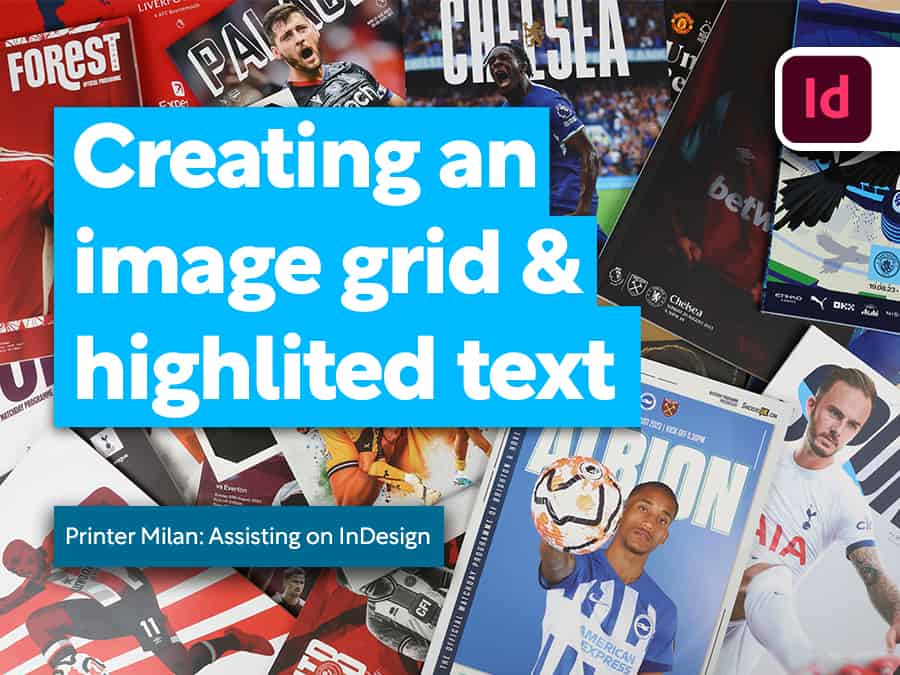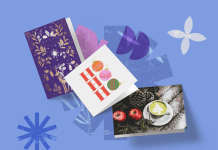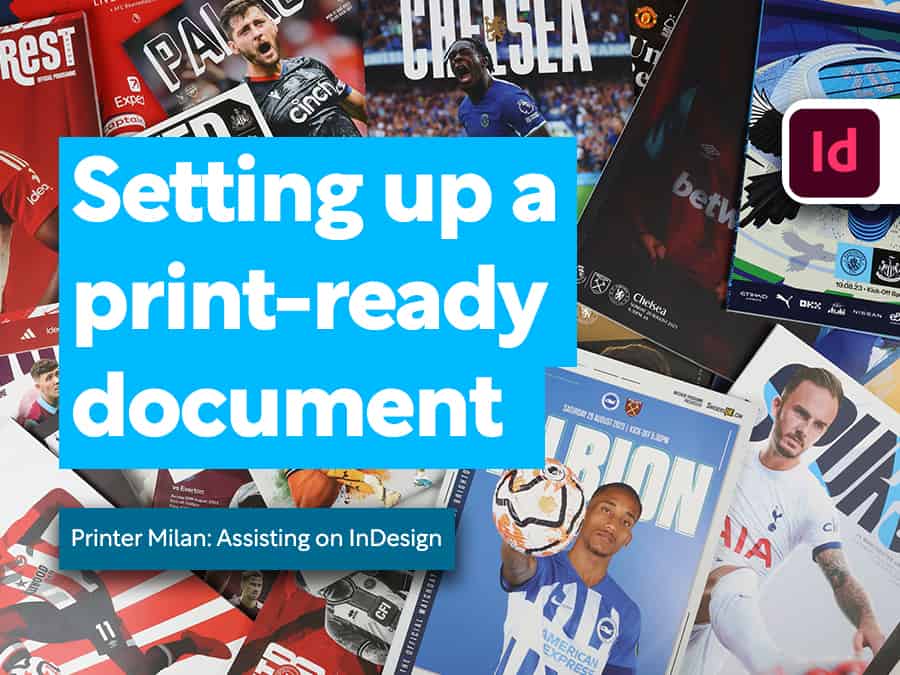Building on the success of our first InDesign tutorial, this next episode dives deeper into essential shortcuts that can help every designer. Save time with character styles, a technique perfect for creating consistent branding, and you can elevate the quality and precision of your designs by mastering image grids.
Inspiration from the pitch to the page
In this second episode of our series, we draw inspiration from the sleek and functional design of Brighton’s programme. The three-column layout, a staple in their design, serves as our template, demonstrating how to effectively balance text and imagery for an engaging visual experience.
Creating image grids with precision
Our tutorial begins with the construction of image grids. We explore the use of InDesign’s rectangle frame tool, emphasizing the importance of precision and alignment. By utilizing keyboard shortcuts and tools like the gap tool, we demonstrate how to create evenly-spaced image grids that enhance the visual appeal of your layout.
Placing and scaling images
Once the grid is set, we walk you through the process of inserting and scaling images. This part of the tutorial focuses on achieving a balanced and proportional look, similar to a clipping mask, ensuring that your images fit perfectly within the designated frames.
Implementing character styles for consistent text formatting
The highlight of our tutorial is the implementation of character styles. This feature in InDesign is a game-changer for ensuring consistent and efficient text formatting. We guide you through setting up a new character style, adjusting font choices, and even adding a creative touch with highlighted text.
Practical application
As we conclude the tutorial, we apply the learned techniques to create a visually compelling layout. This hands-on approach not only reinforces the skills but also demonstrates how these InDesign features can elevate your print projects.
Stay tuned for more
Our journey doesn’t end here. In upcoming episodes, we’ll explore more design aspects from Premier League programmes, each packed with tips and tricks to refine your InDesign prowess.
For those eager to expand their skill set in InDesign, particularly in creating professional and eye-catching layouts, this tutorial is an invaluable resource. Watch our video, follow along, and witness how these techniques can transform your print projects.
If time is of the essence, check out our YouTube Shorts or TikTok to explain these techniques in a matter of seconds.
When you’ve mastered the use of image grids and character styles for your design, our range will be here to perfectly produce your artwork in print!
Transcription
Welcome back to episode two of the series where I’ll be looking through Premier League programmes from this season and each month using them as inspiration to help you guys build your skillset in InDesign.
These tips will help you create your own artwork, which you can then bring to life with print. In the last episode, I took a look at the Wolves programme and showed you how to set up an InDesign document.
In this episode, I’ll be going through the contents page of Brighton’s programme, and showing you how to create a few features they have used.
Here’s a preview of what I’ll be showing you how to create. As you can see, they’ve used a three-column layout to help divide the information and imagery, to help make the page more digestible.
I really like the simplicity of this design, and I believe they have included just the right amount of info to grab your attention. They haven’t overdone it and haven’t left you not knowing what to expect.
The use of image grids to highlight sections of the programme is also a great idea, and you see this through most content pages in football programmes.
In this episode, I’ll be showing you how to create your highlighted text and image grids like they have here. So here is a design I’ve made inspired by the Brighton programme. I’ll be showing you how to create this image grid here with the highlighted text.
I’ve made some space for myself to create the image grids, so let’s begin by doing that. So head over to the toolbar and select the rectangle frame tool. Holding Shift, drag a square like this at the edge of the column but don’t let go of Click and Shift yet.
Use the arrow keys, up, to create two vertically, and then use the arrow keys, right, to create two horizontally and it creates an even space between each image. You can use this tool here, the gap tool, to change the sizing of each one, and you can move it up and down holding Alt. And if you hold Shift, you can separate these two. If you hold Ctrl, you can change a gap like that, and you can do this with any form of grid.
But let’s go back to the two by two, which I had before. So as you saw earlier, I only had one horizontal image at the top, and it’s really easy to do. Just delete one of the boxes and with the direct selection tool, drag this across to the edge. And there we have it, three frames, which we can now put our images in.
So now that we’ve made our image grids, let’s go ahead and place our images, and it’s really easy to do. Select one of the frames, go to file, go down to place, and find the image you would like.
As you can see, it hasn’t scaled the image to a proportional size, so all I need to do is click the circle in the middle here and you’ll see a hand like this. Right-click, select fitting and then fit content proportionally.
As you can see, it still hasn’t fit correctly, but I can now see my image. So to scale your image, make sure you have a brown outline like this. This means I’ll only be changing the image inside the frame and not the frame itself.
So holding Alt + Shift, I’m just gonna scale it up to fit in the frame. As you can see, nothing has gone outside the frame and it’s all stayed inside, similar to a clipping mask. So now I can just repeat the step for the other frames.
I’ve finished adding all my images to the frames, and I’ve also added the copy, which I’ll be showing you how to highlight. So head over to Window, go down to Styles, and select Character Styles, or you can use the shortcut, Shift + F11. And a tab like this will open.
Character styles are really useful as they help you save time and ensure consistent formatting throughout your artwork. There is also a thing called paragraph styles, which I’ll show you how to do in later episodes, but for now, I’m only gonna go through character styles.
Now that we’ve got this tab open, select the plus icon here, and that’ll create a new character style, named character style one. With your text selected, double-click the character style, and a tab like this will open. Check the preview box in the bottom left corner so that you can see all the changes happen in time.
So let’s go down to basic character formats to begin with, and we can now choose which font a sentence will be. And I’m gonna do Proxima Nova, font style, regular, and size 15. And I’m happy with that.
I want my colour to be white as it’s gonna be on a blue background, so I want it to be visible. Now we wanna go to underline options, and this is where we will add our highlight. So in this option, make sure you check underline on, make sure it has a tick box. For now, let’s just change the weight to 10, and then make sure the offset is -3.
So as you can see, the highlight doesn’t cover all the text. So what we need to do is we can just slowly up the weight until it fits over the text. I want to make the colour of the highlight, cyan.
I decided I don’t like 17, and I’m gonna lower it a little bit, just so that there’s a gap between each line. You can also change the gap colour, but I’m gonna leave it how it is for now and click OK. I’m gonna have to make my textbook a little bit larger, just so the sentence fits within it.
Now all I need to do is select my other sentences, and I can just apply this character style, like that. And I can do it for this sentence here as well. And as you can see quickly, I’ve just added this style and highlighted all these sentences.
Thanks for watching this episode, and I hope I was able to teach you a few tricks which you can use in your current print project or a future one. And don’t forget to stay tuned, when I’ll be going through the West Ham programme and showing you even more tricks, which you can use in your print.




